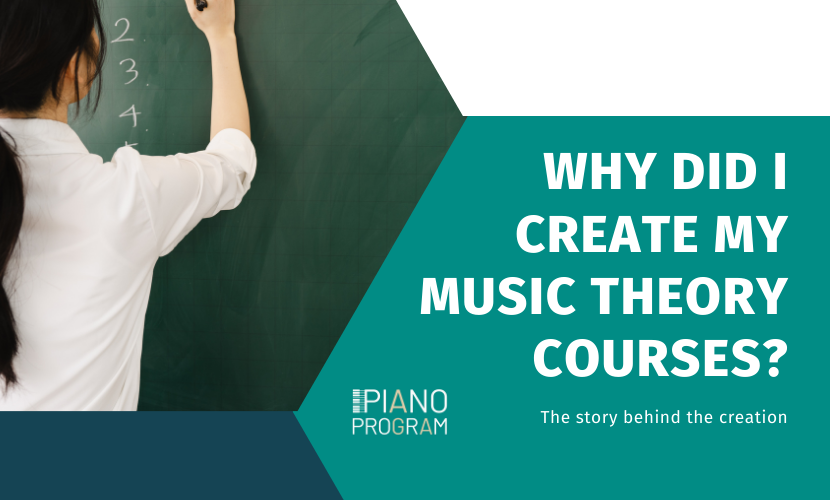There’s a story behind the “why!”
They say, hindsight is 20/20. Or using another verbal example, sometimes it’s hard to see where we are going until we stop and look to see where we’ve been.
One of my first university jobs, after graduating with my doctorate in piano pedagogy, was to teach both group piano and music theory to undergraduate music majors. Up to this point, I had been teaching private piano for many years, and my private piano lessons always included music theory. But it wasn’t until I had a classroom full of freshmen and sophomore undergraduate music majors did I see the incredible differences in how students were prepared for college level music classes.
Sequencing Instruction
You see, almost everything we learn for our college degrees is set along a curriculum that is set out for us. For example, we study geometry and algebra and calculus at the high school level, but it is the elementary years that sets the foundation of addition, subtraction, multiplication, and many other skills that lead us up to more advanced high school and eventually university level math study. Experts in the field have come up with a ‘what needs to be taught when’ order and sequence that works well for our gradual learning styles.
But in music, that field is WIDE open. How we sequence music instruction as a private teacher is varied and complicated. Yes, we want students playing Beethoven Sonatas and understanding key signatures and chord construction. But how to we get there? What is the best way to teach that year by year?
These were just some of the questions I was pondering as I was teaching music theory to my new college freshmen. Because these students, brilliant as they all were, each possessed a wide variety of music theory knowledge. Some had studied music theory very thoroughly at the pre-college level, and some had not. It was my job, as a professor, to get them all on the same level of understanding. But I thought to myself, how much better would it be if this knowledge would have been taught during the pre-college years when these students were all taking private music instruction?

Fast forward a few years
Just a few years later, I was founder and owner of a multi-teacher music school, responsible not only for teaching piano to my own piano students, but responsible for guiding other teachers in teaching the other 300+ students who were enrolled at my music school. Now my responsibility had increased tremendously!
During our monthly staff meetings, here is what I discovered:
- Teachers knew about the importance of teaching music theory, but they didn’t know how and when to teach all of the concepts.
- Many students take lessons for 12 years before college! That is a long time to think about what concepts to teach when. Many teachers were overwhelmed with this responsibility
- More importantly, we were ALL strapped for time. Many students took only 30 minute private lessons. How could we fit in music theory instruction when we were all teaching music, and scales, and note-reading?
I knew that it was my responsibility to not only guide these teachers, but to also make sure that all of our students were prepared for those college level music theory classes that I taught a few years back. It was my responsibility both as a music school owner and a teacher to adequately prepare everyone.
And so it began. I decided to create courses, one for each level of pre-college study, from 1st – 12th grade. Each level would contain just the exact right amount of music theory knowledge for the students of each grade level. Not enough to overwhelm, but enough so that as they took lessons every year, their music theory knowledge would grow with them.
I divided up music theory knowledge into an appropriate sequence for each grade level, and started creating graphics and videos of me teaching the concepts. Then the tech nitty-gritty began! I researched course platforms, microphones, software for music examples, and software for graphics. I researched the best way to create a PDF and printable workbook that would accompany each level because I believed that true learning also came from writing concepts.
Learning at home
After a few years of hard work, I was ready to introduce my music theory courses not only to my own students but also to the teachers that I employed. Our students now had the ability to use my course materials at home, or during lab time in their lessons, and watch my instructional videos. This saved us all a tremendous amount of time. They had my workbooks to reinforce the concepts, and would come back to lessons ready to integrate what they had learned. All of our students, regardless of their playing ability, were able to understand the concepts for their grade level. All were prepared for university level music theory should they decide to study through the high school years.
It has been such a delight watching my music theory courses grow over the year! Other piano teachers around the world have purchased access to the courses to use in their own studios. Private students of other teachers are also supplementing their own lessons by enrolling in an individual level. It’s an exciting process, watching music theory knowledge grow in so many students!

